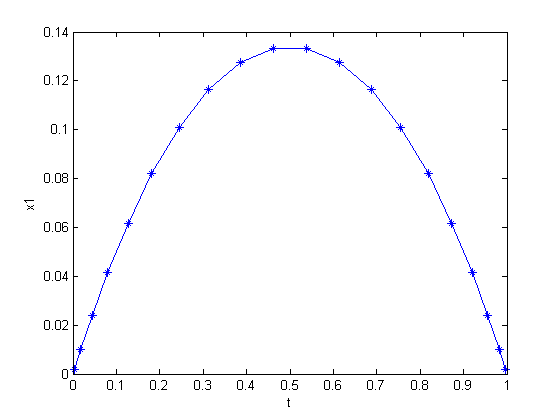Curve Area Maximization
On smooth optimal control determination, Ilya Ioslovich and Per-Olof Gutman, Technion, Israel Institute of Technology.
Example 3: Maximal area under a curve of given length
Contents
Problem Description
Find u over t in [0; 1 ] to minimize:

subject to:


![$$ x(t_0) = [0 \ 0] $$](xcurveAreaMaximization_eq01247.png)
![$$ x(t_f) = [0 \ \frac{pi}{3}] $$](xcurveAreaMaximization_eq09735.png)
% Copyright (c) 2007-2008 by Tomlab Optimization Inc.
Problem setup
toms t p = tomPhase('p', t, 0, 1, 20); setPhase(p); tomStates x1 x2 tomControls u x0 = {icollocate({x1 == 1, x2 == t*pi/3})}; % Boundary constraints cbnd = {initial({x1 == 0; x2 == 0}) final({x1 == 0; x2 == pi/3})}; % ODEs and path constraints ceq = collocate({dot(x1) == u dot(x2) == sqrt(1+u.^2)}); % Objective objective = -integrate(x1);
Solve the problem
options = struct;
options.name = 'Curve Area Maximization';
solution = ezsolve(objective, {cbnd, ceq}, x0, options);
Problem type appears to be: lpcon
===== * * * =================================================================== * * *
TOMLAB - Tomlab Optimization Inc. Development license 999001. Valid to 2010-02-05
=====================================================================================
Problem: --- 1: Curve Area Maximization f_k -0.090586077493297917
sum(|constr|) 0.000000083570791380
f(x_k) + sum(|constr|) -0.090585993922506533
f(x_0) -0.999999999999997560
Solver: snopt. EXIT=0. INFORM=1.
SNOPT 7.2-5 NLP code
Optimality conditions satisfied
FuncEv 1 ConstrEv 82 ConJacEv 82 Iter 49 MinorIter 91
CPU time: 0.093750 sec. Elapsed time: 0.093000 sec.
Plot result
t = subs(collocate(t),solution); x1 = subs(collocate(x1),solution); figure(1); plot(t,x1,'*-'); xlabel('t') ylabel('x1')
